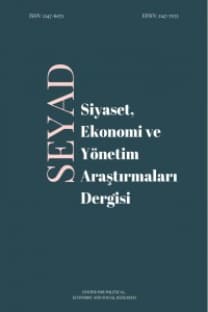Enflasyon’un Türkiye için Refah Maliyeti
Enflasyonun Refah Maliyeti, Para Talebi, Eşbütünleşme, Faiz Esnekliği
The Welfare Cost of Inflation in Turkey
___
- Akaike, H. (1973), “Information Theory and an Extension of the Maximum Likelihood Principle Second International Symposium on Information Theory”, Budapest: Academiai Kiado.
- Bailey, M. J. (1956), “The Welfare Cost of Inflationary Finance”, Journal of Political Economy, 64(2), p. 93–110.
- Cagan, P. (1956), “The Monetary Dynamics of Hyperinflation”, In Studies in the Quantity Theory of Money, ed. Milton Friedman, 25–117, Chicago, University of Chicago Press.
- Dickey, D. A. and Fuller W. A. (1979), “Distribution of the Estimators for Autoregressive Time Series with a Unit Root”, Journal of the American Statistical Association, 74 (366), p. 427–431.
- Ireland, P. (2009), “On the Welfare Cost of Inflation and the Recent Behavior of Money Demand”, American Economic Review, 99(3), p. 1040–1052.
- Johansen, S. (1991), “Estimation and Hypothesis Testing of Cointegration Vectors in Gaussian Vector Autoregressive Models”, Econometrica, 59 (6), p.1551–1580.
- Kimbrough, K. and Spyridopoulos, I. (2012), “The Welfare Cost Of Inflation In Greece”, South- Eastern Europe Journal of Economics, 10(1), p. 41-52.
- Kwiatkowski, D., Phillips, P. C. B., Schmidt, P., and Shin, Y. (1992), “Testing the Null Hypothesis of Stationarity against the Alternative of a Unit Root”, Journal of Econometrics, 54, p. 159–178.
- Lopez, M. (2001), “Seigniorage and the Welfare Cost of Inflation in Columbia”, Ensayos Sobre Politica Economica, 39, p. 115-131
- Lucas, R. E. (2000), “Inflation and Welfare”, Econometrica, 68(2), p. 247–274.
- Meltzer, A. H. (1963), “The Demand for Money: The Evidence from the Time Series”, Journal of Political Economy, 71(3), p. 219-246.
- Newey, W. K. and West, K.D. (1987), “A Simple, Positive Semi-Definite, Heteroskedasticity and Autocorrelation Consistent Covariance Matrix”, Econometrica, 55(3), p. 703–708.
- Serletis, A. and Yavari, K. (2004), “The Welfare Costs of Inflation in Canada and the United States”, Economics Letters, 84, 199-204.
- Serletis, A. and Yavari, K. (2007), “On the Welfare Cost of Inflation in Europe”, Applied Economic Letters, 14, p. 111–113.
- Sidrauski, M. (1967), ‘‘Rational Choice and Patterns of Growth in a Monetary Economy’’, American Economic Review, 57, p. 534-544.
- Stock, J. H. and Watson, M. W. (1993), “A Simple Estimator of Cointegrating Vectors in Higher Order Integrated Systems”, Econometrica, 61(4), p. 783– 820.
- Gupta, R. And Uwilingiye, J. (2008), “Measuring the Welfare Cost of Inflation in South Africa”, South African Journal of Economics, 76(1), p. 16-25 TUIK (Turkish Statistical Institute) (2014), “Statistical Indicators: 1923-2013”. http://www.tuik.gov.tr/Kitap.do?metod=KitapDetay&KT_ID=0&KITAP_ID=160, (23.10.2016)
- ISSN: 2147-6071
- Yayın Aralığı: Yılda 2 Sayı
- Başlangıç: 2014
- Yayıncı: Politik Ekonomik ve Sosyal Araştırmalar Merkezi
Yatırımcılar Rasyonel midir? BİST'te Aşırı Güven ve Aşırı Optimizm Ön Yargıları Üzerine Bir Çalışma
Swot Analysis for Determining the Tourism Potentials of Certain Regions: Akçakoca
Meslek Edindirme Kurslarının Etkinliği: SAMEK Örneği
Damla BAĞLAN, Fatih YARDIMCIOĞLU
The Relationship Between Unemployment Rate and Economic Growth: The Case of Turkey
Mehmet MUCUK, Ayşen EDİRNELİGİL, Mustafa GERÇEKER
Enflasyon’un Türkiye için Refah Maliyeti
Sınıflandırılmış Fayda ve Sakıncalarıyla Paylaşım Planları ve Türkiye’deki Yasal Durum
Human Capital and Economic Growth: Bounds and Causality Analysis for Turkey
Çalışma Koşullarının Hava Trafik Kontrolörlerinin Bağlamsal Performansı Üzerine Etkisi
International Tourist Arrivals by Region of Origin and Tourism Receipts: a Panel Data Analysis
